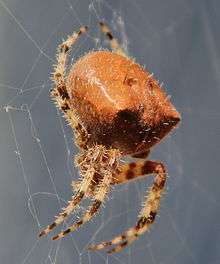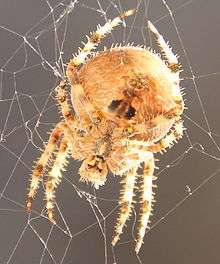Araneus gemmoides
| Jewel spider | |
|---|---|
 | |
| Scientific classification | |
| Kingdom: | Animalia |
| Phylum: | Arthropoda |
| Class: | Arachnida |
| Order: | Araneae |
| Suborder: | Araneomorphae |
| Superfamily: | Araneoidea |
| Family: | Araneidae |
| Genus: | Araneus |
| Species: | A. gemmoides |
| Binomial name | |
| Araneus gemmoides Chamberlin & Ivie, 1935 | |

Araneus gemmoides, commonly known as the jewel spider (a name shared with Austracantha minax) and cat-faced spider (a name shared with Araneus gemma), is a common outdoor orb-weaver spider found in the USA and Canada.[1] They are considered harmless and have low-toxicity venom.[2] A. gemmoides are useful natural predators for insects.[1][3][4]
A. gemmoides make their webs near lights, closed spaces, and on the sides of buildings. They can also be found under wood, overhangs, or guarded places such as animal burrows.[5] They come in varying colors but are easily identified by the two horn shaped growths on their relatively large abdomen. Their color changes from summer to winter.[2]
The female will die within days of laying a single egg sac with hundreds of eggs. Egg sacs can survive over winter, and the emerging spiderlings will eat their brothers and sisters. The babies ride strands of silk in warm air currents, able to transport them to locations miles away.[1]
See also
References
- 1 2 3 staff, the Bug Room (19 August 2004). "Bug Facts Jewel Spider (Araneus gemmoides)". Royal Alberta Museum. Retrieved 8 September 2013.
- 1 2 Cranshaw, Whitney. "Cat Faced Spider". CSU/Denver County Extension Master Gardener 2010. Retrieved 25 September 2011.
- ↑ Hoang, Linda (29 August 2012). "Big jewel spiders nothing to worry about, says city entomologist". Bell Media, CTV Edmonton News. Retrieved 8 September 2013.
- ↑ "Insect of The Week - Cat Face Spider". Washington State University, Department of Entomology. Archived from the original on 1 October 2011. Retrieved 25 September 2011.
- ↑ Johnson, Prof. Dan L. (2004). "A 'LOST WORLD' BATTLE (...go to heading...) Some other grassland arachnids you might see". University of Lethbridge. Retrieved 25 September 2011.